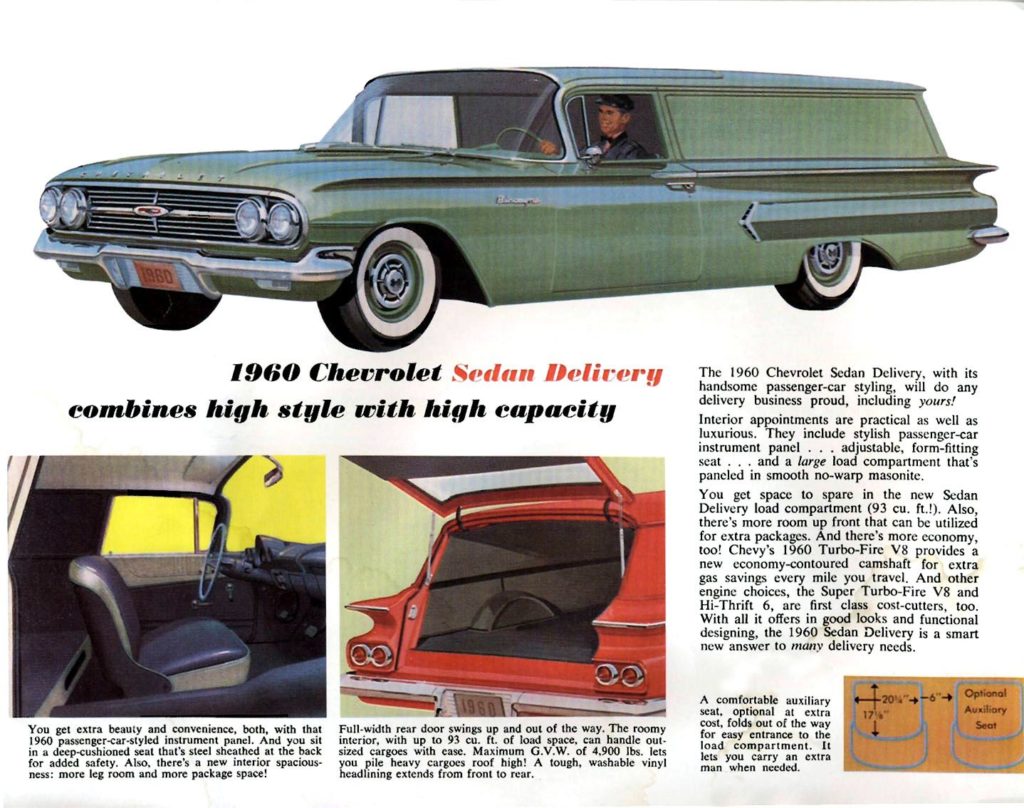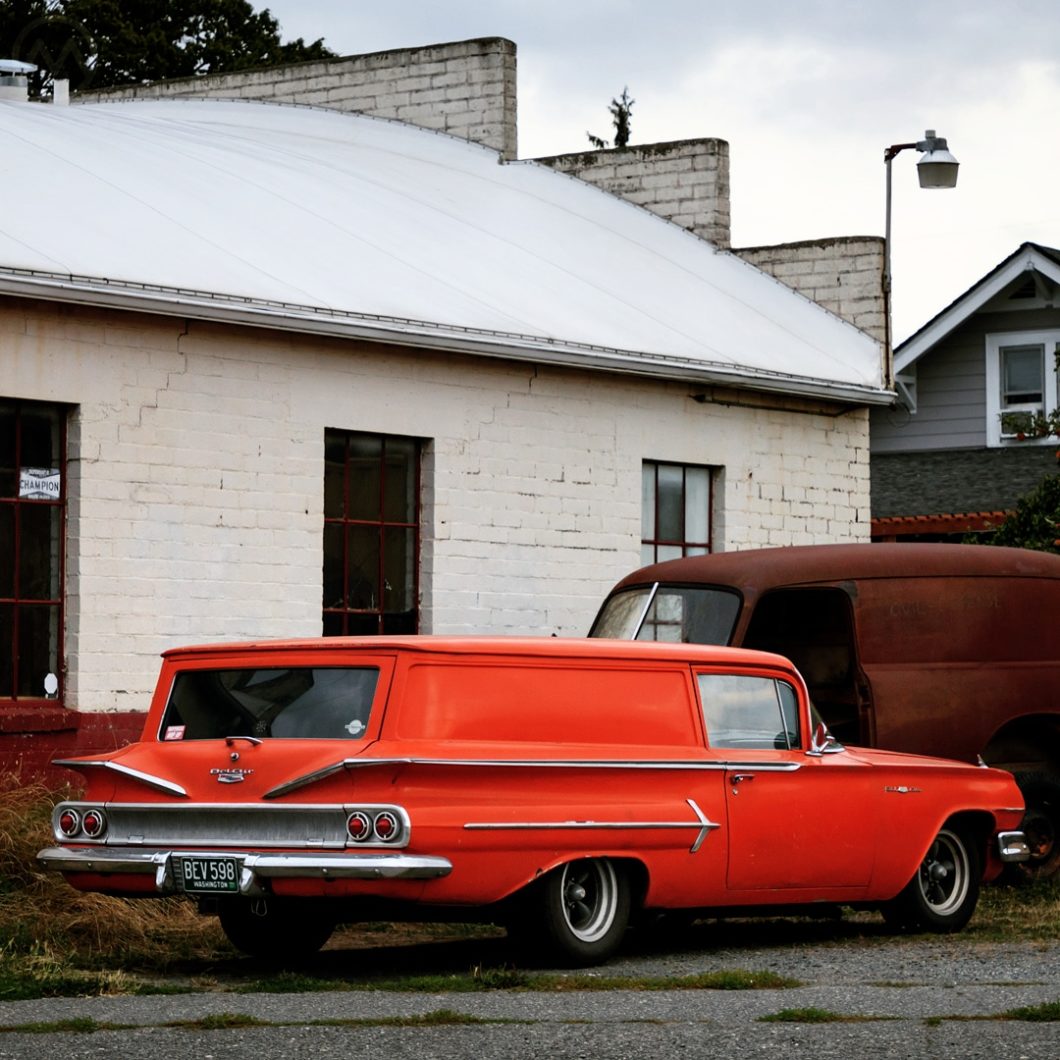It says “Bel Air” on it, but those badges were added later. Sedan deliveries became common as hot rods in the 1960s, but they were plain and basic work vehicles first – and definitely not as fancy as a Bel Air. At Chevrolet in 1960 they were in the same series as the base-model Biscaynes – but they were commercial vehicles, marketed and badged somewhat differently.
Car-based vans survive to this day on smaller vehicles in other countries and smaller sedan deliveries continued in the U.S. for long awhile too; but the era of full-sized American sedan deliveries was fast coming to an end in the late 1950s. Chevy was the final holdout, and 1960 was the final year it offered a full-sized sedan delivery.
Car-based Vans Evolve
The term “Sedan delivery” dates back to the 1920s, when pickup and van bodies could easily be added to production car models, although there had been plenty of car-based “Delivery” vehicles in prior years. By the end of that decade Chevy and Ford catalogued car-based vans as well as heavier panel trucks.
Many U.S. manufacturers followed suit and offered small commercial sedan deliveries in the 1930s but drifted away from the type as body tooling costs sometimes outweighed how many they could actually sell; and some just offered them because they needed whatever sales they could get – American Bantam and Crosley both built tiny ones (the Crosley was built in much larger numbers).
In some cases, like at Studebaker, they built two-door sedans with blanked-out windows and no back seat – a kind of “Panel business coupe” instead of proper delivery. Chrysler let the style essentially fall away.
Even Ford, which had a thriving delivery trade in the 1930s, did not offer one from 1946-51. If you see a “shoebox” Ford Sedan delivery, it’s something somebody built.
That left GM – specifically Chevy and Pontiac (since it shared bodies with Chevrolet) – as the market leader on sedan deliveries, but the type got a surprising revival after 2-door station wagons became a trend in the 1950s. If you were building a 2-door wagon anyway, a sedan delivery was cheap to add. That essentially revived the waning bodystyle, particularly for Ford.
Big Sedan Deliveries Give Way to Small Vans
But by the mid-1950s small forward-control vans began to horn in on big sedan deliveries. Beloved of surfers and hot rodders later, in the 1950s sedan deliveries were mostly fleet or commercial vehicles and rarely equipped with anything but the most basic amenities and engines.
A VW Type 2 or Ford Thames 400e offered a better business case to those looking for an economical delivery vehicle, and the landscape changed to suit. Studebaker had continued with the panel-windows, only on wagons after 1956, and in 1959 that treatment transferred over to the Lark.
A year and half later, in late 1960, Ford transferred the full-size sedan delivery to the Falcon body, though it continued building 2-door wagons for awhile. By then the Ford Courier had glass windows, making not quite a full “sedan delivery.” At the same time, Ford and Chevy were designing domestic forward-control light vans of their own.

With the Corvair van in the wings for 1961, Chevy offered one last big sedan delivery in 1960. Inside a fleet buyer might find only one seat for the driver and 93 cubic feet of space accessed by a one-piece, swing-up tailgate. They could be very minimal inside or come with a fully-carpeted interior and an optional passenger’s seat.
The two variants of Sedan Delivery were series 1170 and 1270, both in the Biscayne range as far as trims and equipment. Supposedly as many as 5,310 were sold that year – about 1/3rd as many as the 2-door Biscayne passenger wagons, but estimates seem to vary. They were powered by the old 235-cid six or the newer “Turbo Fire” 283 V8.
Offering the 2-door wagon and the El Camino made economies of scale better on the sedan delivery, but all three were axed after 1960, though the El Camino would later return.
With minimal equipment, they were cheap to buy used and often lightweights, which made them an optimal choice for hot rods or parts haulers (which is the job some of them did in the first place). Older sedan deliveries became dragway favorites in the sixties and have been popular hot rods ever since.
Gone But Not Forgotten
Chevrolet did return to offering a sedan delivery about a decade later – with the Vega Panel wagon, a much smaller vehicle that was closer in concept to international-sized car-based vans, which were still going strong in markets where a really small vehicle was needed for delivery purposes.
European and Japanese “car vans” never really went away and ran the gamut from “hatch with windows” (Ford Fiesta, right up to the present day) to “small car with integrated cargo box” (Citroën C15, Fiat Fiorino). In the USA, Minivans briefly revived the panel van concept but were later supplanted by the modern Euro-style small vans a-la Ford Transit Connect, just as many of the cargo-box style Euro vans were.


Pingback: Last of a Dying Breed: 1960 Chevrolet Sedan Delivery | Barn Finds